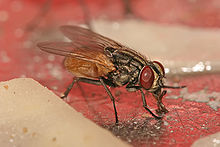House fly
| Housefly | |
|---|---|
 |
|
|
Not evaluated (IUCN 3.1)
|
|
| Scientific classification | |
| Kingdom: | Animalia |
| Phylum: | Arthropoda |
| Class: | Insecta |
| Order: | Diptera |
| Section: | Schizophora |
| Family: | Muscidae |
| Genus: | Musca |
| Species: | M. domestica |
| Binomial name | |
|
Musca domestica Linnaeus, 1758 |
|
| Subspecies | |
|
|
The housefly (also house fly, house-fly or common housefly), Musca domestica, is a fly of the suborder Cyclorrhapha. It is believed to have evolved in the Cenozoic era, possibly in the Middle East, and has spread all over the world. It is the most common fly species found in habitations. Adult insects are grey to black with four dark longitudinal lines on the thorax, slightly hairy bodies and a single pair of membranous wings. They have red eyes, and the slightly larger female has these set further apart than the male.
The female housefly usually only mates once and stores the sperm for later use. She lays batches of about 100 eggs on decaying organic matter such as garbage, carrion or feces. These soon hatch into legless white maggots which after 2 to 5 days of development transform into reddish-brown pupae, about 8 mm (0.3 in) long. Adult flies normally live for 2 to 4 weeks but can hibernate during the winter. The adults feed on a variety of liquid or semi-liquid substances beside solid materials which have been softened by saliva. They carry pathogens on their bodies and in their feces and can contaminate food and contribute to the transfer of food-borne illnesses. For these reasons they are considered pests, but have been used in the laboratory in research into ageing and sex determination.
Adult houseflies grow to 8–12 millimetres (0.3–0.5 in) long. The thorax is gray or sometimes even black, with four longitudinal dark lines on the back. The whole body is covered with hair-like projections. The females are slightly larger than the males, and have a much larger space between their red compound eyes.
Pupae can range from about 8 to 20 mg under different conditions.
Like other Diptera (meaning "two-winged"), houseflies have only one pair of wings; what would be the hind pair is reduced to small halteres that aid in flight stability. Characteristically, the media vein (M1+2 or fourth long vein of the wing) shows a sharp upward bend.
...
Wikipedia
